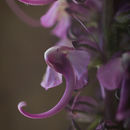en
names in breadcrumbs


Pedicularis groenlandica is a showy flowering plant in the family Orobanchaceae which is known by the common names elephant's head, elephant-head lousewort[1] and butterfly tongue.[2]
This erect plant can grow to a height of 80 centimetres (31 in). Its sharply-toothed fernlike leaves are located low on the stout stem. The stem is topped with a large inflorescence of bright pink to purple or white flowers. Each flower has a long, pointed beak which curves upward, superficially resembling the trunk of an elephant, and the lateral lobes of the flower resemble an elephant's ears. Flowers bloom June to August.[3]
Like other louseworts and related broomrape genera, this is a root hemiparasite which obtains nutrients from the roots of other plants by piercing them with haustoria.
This plant is found in the high mountain ranges of western North America, including the Cascades, High Sierra, Rocky Mountains, much of Canada, and Greenland.[4][5] In Greenland however, it is only found a in a single valley southest of Nuuk.[6][4]
It grows in moist mountain meadows.[3]
Pedicularis groenlandica was first described in 1795 by Anders Jahan Retzius in Florae Scandinaviae Prodromus.[7] In the year 1900 the famous botanist Per Axel Rydberg placed it in a new genus with the charming name Elephantella groenlandica, but this classification is not accepted by Plants of the World Online (POWO), World Flora Online (WFO), or the USDA Natural Resources Conservation Service PLANTS database (PLANTS).[8][9][10]
Colony along Firehole River, Yellowstone National Park
{{cite book}}: CS1 maint: others (link) Pedicularis groenlandica is a showy flowering plant in the family Orobanchaceae which is known by the common names elephant's head, elephant-head lousewort and butterfly tongue.
 Pedicularis groenlandica illustrated by CJ Marvin, from Wild Flowers and Trees of Colorado by Francis Ramaley 1909
Pedicularis groenlandica illustrated by CJ Marvin, from Wild Flowers and Trees of Colorado by Francis Ramaley 1909 This erect plant can grow to a height of 80 centimetres (31 in). Its sharply-toothed fernlike leaves are located low on the stout stem. The stem is topped with a large inflorescence of bright pink to purple or white flowers. Each flower has a long, pointed beak which curves upward, superficially resembling the trunk of an elephant, and the lateral lobes of the flower resemble an elephant's ears. Flowers bloom June to August.
Like other louseworts and related broomrape genera, this is a root hemiparasite which obtains nutrients from the roots of other plants by piercing them with haustoria.